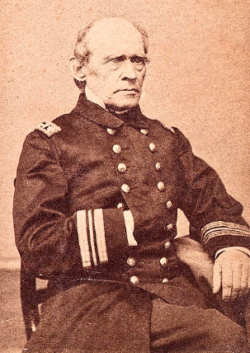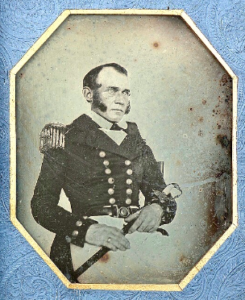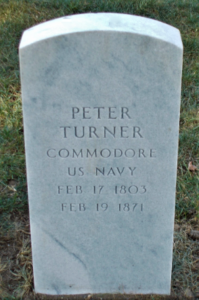Title: Navy Lieutenant, Mexican War, Commodore, Civil War; governor of the Naval Asylum
Birthdate: February 17, 1803
Death Date: February 19, 1871
Plot Location: Naval Plot Row 5, grave 2

Not many men have dedicated 48 of their 68 years to active service in the United States Navy, and even fewer have had the naval pedigree that belonged to Peter Turner. His father was a surgeon in the Navy during the Quasi War with France in 1798 and three uncles were Naval officers. The most famous was Daniel Turner, commander of the brig Caledonia during the War of 1812.
Peter was one of nine children of this Turner family that had been anchored to Newport, Rhode Island for generations. His military ancestry has been traced to Captain William Turner who was shot while fighting Native American tribes in Massachusetts in 1676 at the Battle of Turner’s Falls (more correctly known as the difficult-to-pronounce Peskeompscut-Wissantinnewag Massacre).
Peter received his warrant as a midshipman in 1823 but wasn’t promoted to lieutenant until 1832. Meanwhile Uncle Daniel became a commodore, an honorary title in the antebellum Navy for captains who commanded two or more ships operating together. He brought Peter along with his squadron on an expedition to Brazil between 1834 and 1835, and again when he commanded the USS Constitution in 1840 and 1841.
It was in October of 1842 that the 39-year-old Peter married 16-year-old Sarah Stafford Jones, making their home in Newport where most of their five children were born. Despite the age difference, she outlived her husband by only four years.
 When Lt. Turner was again at Rio De Janeiro in 1844 he sat for this original “daguerreotype” photograph. This is a remarkably well-preserved image, considering the very first photograph ever taken of a human being was in 1839 by Louis-Jacques-Mandé Daguerre in Paris. By the mid-1840s daguerreotype portrait studios were appearing on both sides of the Atlantic despite the practical impossibility of making more than one print from the silver-coated copper plate.
When Lt. Turner was again at Rio De Janeiro in 1844 he sat for this original “daguerreotype” photograph. This is a remarkably well-preserved image, considering the very first photograph ever taken of a human being was in 1839 by Louis-Jacques-Mandé Daguerre in Paris. By the mid-1840s daguerreotype portrait studios were appearing on both sides of the Atlantic despite the practical impossibility of making more than one print from the silver-coated copper plate.
During the Mexican War in 1847 the lieutenant witnessed the Battle of Vera Cruz and was on expeditions to Tuspan and Tabasco. He returned to “special duty” at the Portsmouth, New Hampshire Navy Yard where his only daughter that survived to adulthood was born. The only time he was in command of a vessel was from December 30, 1850 to October 31, 1851. The USS Southampton was a supply ship that set sail from the Brooklyn Navy Yard, traveled around Cape Horn, and arrived at San Francisco harbor.
He was placed on the reserved list in 1855 and was on waiting orders until 1861. A long-awaited promotion to commander finally came when the “war of the rebellion” was three months old. In 1862 Congress made the grade of Commodore an official rank, and he was among 18 captains who were promptly promoted. He was 59 years old. With his new rank he was then appointed governor of the U.S. Naval Asylum in Philadelphia, one old sailor in charge of many others.
The Commodore sat for his last photograph, shown above, on October 12, 1863 with his hand in a Napoleon-like pose. That was commonly done in mid-19th century photography to indicate a person’s position of leadership or a stately manner. 
Death came two days after his 68th birthday. The New York Herald remembered him as “a popular and gallant officer, and his death takes away another from among the few remaining naval officers of the olden time.” His wife and a son share a headstone beside his in the Naval Plot on the Yeadon side of Mount Moriah.

Support the Friends of Mount Moriah
Help us in our mission to restore and maintain the beautiful Mount Moriah Cemetery by donating to our cause or volunteering at one of our clean-up events.

